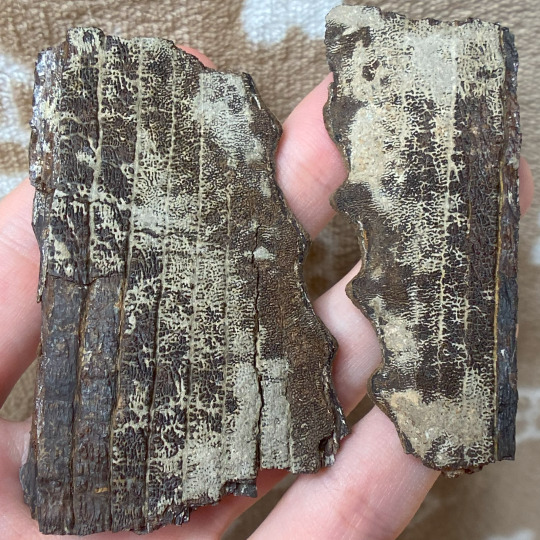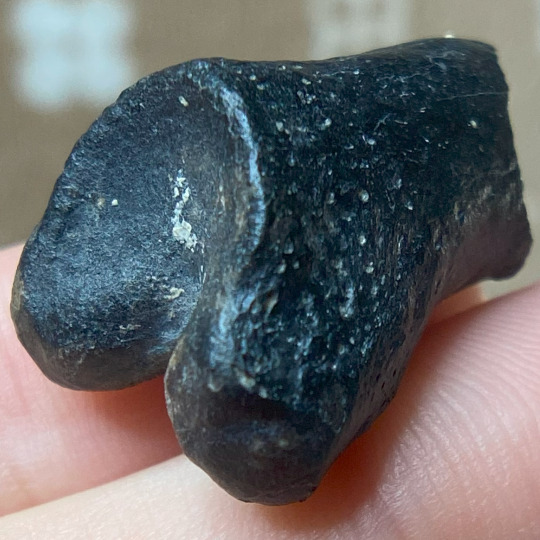Fossil collector & amateur / hobby paleontology of dinosaurs & other prehistoric fauna. Not a certified paleontologist. 化石コレクター🦖🦕Specimens shown are primarily for show & NOT for sale or trade.
Last active 60 minutes ago
Don't wanna be here? Send us removal request.
Text

A very worn dinosaur tooth of an indeterminate theropod, possibly Ceratosaurus sp. from the Lourinhã Formation in Lourinhã, Portugal. The teeth of Ceratosaurus can be quite compressed as seen in this specimen. The CBL is 12.8mm and the CBW is 4.8mm giving it a CBR of 0.37 which seems Ceratosaurus-ish. However, theropod teeth can be very similar to one another, especially those from the Jurassic. Unfortunately, the serrations are completely worn away, even under a scope.
#dinosaur#fossils#paleontology#palaeontology#paleo#palaeo#ceratosaurus#ceratosauridae#theropod#jurassic#mesozoic#prehistoric#science#paleoblr#fossil friday#fossilfriday#ケラトサウルス#ケラトサウルス科#恐竜#化石#古生物学
7 notes
·
View notes
Text

A pair of indeterminate crocodylomorph teeth, possibly alligatoroid from the Aquia Formation in Belvedere, King George County, Virginia, USA. This Paleocene aged deposit produces a number of crocodylomorph genera.
#crocodylomorpha#crocodilian#fossils#paleontology#palaeontology#paleo#palaeo#eusuchia#paleocene#cenozoic#science#prehistoric#paleoblr#正鰐類#ワニ#化石#古生物学
4 notes
·
View notes
Text

A dinosaur humerus of an indeterminate sauropod, possibly Tangvayosaurus hoffeti from the Grès supérieurs Formation in the Savannakhet Province of Laos. For this particular deposit, the bone is surprisingly complete and in decent quality. While Tangvayosaurus is the only described sauropod, there are likely many more species yet to be described.
#dinosaur#fossils#paleontology#palaeontology#paleo#palaeo#tangvayosaurus#euhelopodidae#sauropod#cretaceous#mesozoic#prehistoric#science#paleoblr#fossil friday#fossilfriday#タンヴァイオサウルス#エウヘロプス科#恐竜#化石#古生物学
16 notes
·
View notes
Text

A plesiosaur vertebra of an indeterminate pliosaurid from the Oxford Clay from Oday Common, Abingdon, Oxfordshire, United Kingdom. This deposit contains multiple genera such as Liopleurodon and Pliosaurus making identification difficult. Abingdon marine reptiles bones are commonly mistaken and sold as dinosaur material, commonly as Cetiosaurus or Dacentrurus, but occasionally Megalosaurus. The notochordal pit in the center of the vertebra is the dead giveaway that this is a marine reptile and not a dinosaur.
#plesiosaur#pliosaur#fossils#paleontology#palaeontology#paleo#palaeo#pliosauridae#jurassic#mesozoic#prehistoric#science#paleoblr#プリオサウルス科#首長竜目#化石#古生物学
10 notes
·
View notes
Text

A very worn dinosaur tooth of a Tyrannosaurus rex from the Hell Creek Formation in Garfield County, Montana, United States. The specimen is likely weather worn from exposure on the surface and was originally found in many pieces. With a length of around 2.2 inches, the tooth would have likely been 3 inches or more had the tip survived. The serrations that remain on the tooth are surprisingly pristine and perfect. It is not the prettiest of Tyrannosaurus teeth, but a T. rex nonetheless.
#dinosaur#fossils#paleontology#palaeontology#paleo#palaeo#tyrannosaurus#tyrannosauridae#tyrannosaurini#tyrannosaurinae#theropod#cretaceous#mesozoic#prehistoric#science#paleoblr#ティラノサウルス#ティラノサウルス科#恐竜#化石#古生物学
18 notes
·
View notes
Text

A fossilized tooth of a woolly mammoth or Mammuthus primigenius in the gravel pits at the Cotswold Water Park, Ashton Keynes, Wiltshire, England. This Upper Pleistocene aged specimen was found in 1984 from an old English collection. Supposedly, all (or most) of the gravel pits at this site have since been filled with water. Unfortunately, this specimen suffered damage during transport and had to be glued back together.
#synapsid#mammal#fossils#paleontology#palaeontology#paleo#palaeo#mammuthus#woolly mammoth#mammoth#proboscidean#pleistocene#cenozoic#prehistoric#science#paleoblr#fossil friday#fossilfriday#ケナガマンモス#ウーリーマンモス#マンモス#化石#古生物学
13 notes
·
View notes
Text

A fossilized crocodilian osteoderm, possibly Thecachampsa sericodon from the Ocala Limestone in the Haile Quarry (Haile sites) of Alachua County, Florida, United States. This specimen was originally found in multiple pieces that were glued back together.
#crocodylomorpha#crocodilian#fossils#paleontology#palaeontology#paleo#palaeo#thecachampsa#gavialosuchus#gavialidae#eusuchia#miocene#cenozoic#science#prehistoric#paleoblr#テカチャンプサ#ガビアロ���クス#正鰐類#ガビアル科#ワニ#化石#古生物学
2 notes
·
View notes
Text

A partial fossilized tooth of an American mastodon or Mammut americanum from the Texas City Dike in Galveston County, Texas, United States. This species lived alongside another proboscidean, the Columbian mammoth or Mammuthus columbi and their teeth can be distinguished from mammoths by their bumpy cusps. This specimen was found in the 1990s and comes from the old collection of the late George E. Wolf of Texas, United States.
#synapsid#mammal#fossils#paleontology#palaeontology#paleo#palaeo#mammut#american mastodon#mastodon#proboscidean#pleistocene#cenozoic#prehistoric#science#paleoblr#fossil friday#fossilfriday#マムート#アメリカマストドン#マストドン#化石#古生物学
2 notes
·
View notes
Text

A mosasaur jaw of a Halisaurus arambourgi from the Couche III in the phosphate mines of Oued Zem, Khouribga, Morocco. The teeth of these halisaurines resemble those of its contemporary relative, Pluridens serpentis, but are smaller and lack the enamel folds towards the base of the crown. Halisaurus is one of the smaller known mosasaurs to be described.
#mosasaur#fossils#paleontology#palaeontology#paleo#palaeo#halisaurus#mosasauridae#cretaceous#mesozoic#prehistoric#science#paleoblr#ハリサウルス#モササウルス科#化石#古生物学
11 notes
·
View notes
Text

Partial pair of fossilized fish fin bones of a Protosphyraena sp. from the Niobrara Chalk in Kansas, United States. The pectoral fins of this Cretaceous aged fish are distinct and easily recognizable. These basal relatives of teleost fish convergently resemble swordfish or marlin having a pointed bill.
#fish#fossils#paleontology#palaeontology#paleo#palaeo#protosphyraena#pachycormidae#cretaceous#mesozoic#prehistoric#science#paleoblr#プロトスフィラエナ#パキコルムス科#化石#古生物学
12 notes
·
View notes
Text

A gastropod fossil of a Campeloma nebrascensis from the Hell Creek Formation in Harding County, South Dakota, United States. This freshwater genus of snail still survives to the present day. While this specimen was originally stated to come from the Lance Formation, the county and state points to the Hell Creek Formation as the Lance Formation is in Wyoming.
#gastropod#snail#freshwater snail#fossils#paleontology#palaeontology#paleo#palaeo#campeloma#viviparidae#cretaceous#mesozoic#prehistoric#science#paleoblr#カンペロマ#タニシ科#タニシ#化石#古生物学
4 notes
·
View notes
Text

A fossilized fish of a Jianghanichthys hubeiensis from Jianghan City, Songei County, Hubei Province, China. This Eocene aged fish is a cypriniform which are represented today by cyprinids like carp as well as their closest relatives like loaches, suckers, and shiners. These fossils were once a fairly common sight in the past, though their supply has dwindled over the years.
#fish#fossils#paleontology#palaeontology#paleo#palaeo#jianghanichthys#jianghanichthyidae#carp#eocene#cenozoic#prehistoric#science#paleoblr#ジャンハンイクチス#ジャンハンイクチス科#化石#古生物学
11 notes
·
View notes
Text

A partial phalange of a Miracinonyx inexpectatus or American cheetah from Sarasota County, Florida, United States. This proximal phalanx was found in an Irvingtonian aged site in direct association with diagnostic specimens of a jaw, maxilla, and other teeth and bones. While called a cheetah, this species of cat is closely related (sometimes as a subgenus) to the genus Puma, otherwise known as cougars or mountain lion, than they are to true cheetahs from Africa.
#synapsid#mammal#fossils#paleontology#palaeontology#paleo#palaeo#miracinonyx#puma#felidae#american cheetah#pleistocene#cenozoic#prehistoric#science#paleoblr#ミラキノニクス#アメリカチーター#ネコ#化石#古生物学
4 notes
·
View notes
Text

A dinosaur tooth of an indeterminate carcharodontosaurid, possibly cf Carcharodontosaurus sp. from the Kem Kem Group in Taouz, Morocco. It's unclear what the tooth morphology of Sauroniops pachytholus is to know for sure if it can be distinguished from Carcharodontosaurus saharicus. While Sauroniops may not be diagnostic down to the genus level, and thus a nomen dubium, it is at the very least typically found as a basal carcharodontosaurid similar to the older Eocarcharia dinops. Thus, it is likely that these more derived carcharodontosaurid teeth belong to Carcharodontosaurus and the more basal Acrocanthosaurus-like teeth belong to Sauroniops. But it is entirely possible that there are additional taxon. Ironically, despite the name, Carcharodontosaurus does not actually possess shark-like teeth like the destroyed Egyptian specimen now referred to as Tameryraptor markgrafi. While Ernst Stromer likely intended the name Carcharodontosaurus for Tameryraptor, due to the weird rules of taxonomy, the name goes to the Moroccan neotype being closer to the Algerian Megalosaurus saharicus tooth taxon than to Tameryraptor.
#dinosaur#fossils#paleontology#palaeontology#paleo#palaeo#carcharodontosaurus#sauroniops#carcharodontosauridae#theropod#cretaceous#mesozoic#prehistoric#science#paleoblr#fossil friday#fossilfriday#カルカロドントサウルス#カルカロドントサウルス科#サウロニオプス#恐竜#化石#古生物学
10 notes
·
View notes
Text

A fossilized tooth of a Pleistocene aged deer, likely the broad-fronted moose or Cervalces latiforns from Győrújfalu, Hungary. This species was one of the largest deer to ever exist, larger than modern day moose.
#synapsid#mammal#fossils#paleontology#palaeontology#paleo#palaeo#cervalces#cervidae#broad-fronted moose#deer#moose#pleistocene#cenozoic#prehistoric#science#paleoblr#セバルシス#シカ科#シカ#ヘラジカ#化石#古生物学
10 notes
·
View notes
Text

A fossilized tooth of a Pinckney's capybara or Neochoerus pinckneyi from Jefferson County, Florida, United States. Part of the bone from the maxilla remains on the tooth. This large rodent was a North American relative of capybaras that lived during the Pleistocene. Today, the clade Caviidae is only native primarily to South America with no surviving members in North America.
#synapsid#mammal#fossils#paleontology#palaeontology#paleo#palaeo#neochoerus#caviidae#capybara#pinckney's capybara#cavy#rodent#pleistocene#cenozoic#prehistoric#science#paleoblr#ネオコエルス#カピバラ#テンジクネズミ科#化石#古生物学
6 notes
·
View notes
Text

A fossilized tooth of a Pleistocene aged camel, likely Camelops sp. from the Texas City Dike in Galveston County, Texas, United States. Although camels are not typically thought as native North American fauna, much like prehistoric horses, these animals once roamed the United States with Camelops being the last of the ancient American camels.
#synapsid#mammal#fossils#paleontology#palaeontology#paleo#palaeo#camelops#camelidae#camel#pleistocene#cenozoic#prehistoric#science#paleoblr#カメロプス#ラクダ科#ラクダ#化石#古生物学
13 notes
·
View notes